- Definitions: marketing personalization
- Definitions: customer data infrastructure
- Definitions: being creepy
- What makes personalization cross the line?
- Example #1: Target
- Example #2: Pinterest
- Personalization vs stalking
- Personalization vs profiling
- How to make personalization effective
- Real Thread case study
- Carolina Designs case study
- Effin Amazing example
- Conclusion (& free guide)
In B2B, 98% of marketers agree that marketing personalization helps advance customer relationships, with 74% claiming it has a “strong” or “extreme” impact.
In B2C, research by Accenture states that 75% of consumers are more likely to buy from a retailer that recognizes them by name, recommends options based on past purchases, or knows their purchase history.
Still, marketers struggle to prioritize personalization. It is considered the most difficult online tactic to execute in a marketing strategy.
The most common hurdles clients often bring up include siloed organizational structures, lack of internal experience, lack of clear direction from leadership, or lagging marketing technology.
Personalization is complex. Executing personalization without being creepy requires a lot of technical know-how, and the room for error is scary. At the same time, personalization is expected, and there are straightforward concepts you can apply to avoid mishaps.
To help you raise the bar instead of crossing the line, we’ve compiled this best practice guide rooted in experience with our clients and our own brands. Read on.
Definitions first
Marketing personalization
Also referred to as personalized marketing communication, marketing personalization is the tactic of delivering tailored messages to the individuals you market to. The tailoring is based on the information you collect about their touchpoints with your marketing, as well as about their demographics and other useful traits.
Customer data infrastructure
Customer data infrastructure is the technical foundation that provides three critical capabilities:
- data integration
- data governance
- audience management
As Segment puts it, together these components help you connect and unify customer data, ensure the data is accurate, and cater customer interaction to that individual’s preferences.
Along with Segment, popular CDI tools include mParticle or MetaRouter. They all allow you to implement once and connect dozens of tools. This means you won’t be dependent on lengthy integrations to get a tool up and running. With a CDI, you can switch tools whenever you like and remain agile with your entire stack.
Being creepy
The Oxford dictionary defines creepy as “causing an unpleasant feeling of fear or unease.” Other definitions range anywhere from dishonorable to offensive.
Don’t be either. Do marketing personalization right. Follow this guide.
When does personalization get creepy?
Notorious examples of personalization crossing the line have a couple of things in common:
- The customer felt like the brand knew too much
- The customer felt more harm than good
Let’s get to the root of those statements. Imagine you’re the recipient of personalized marketing communication. It’ll be personalization gone wrong when the following five factors are mishandled.
The list is representative, but not exhaustive:
- Time and place – you receive the personalized communication in a time or place inconvenient to you
- Intent – you receive it when the intent of the action you are about to take is far different from the next step promoted by the marketer. There’s a reason Google has shifted to focusing on intent.
- Value to the customer, not the marketer – you are happy to see others thrive, but you care about yourself first. When you feel like the marketer gets more value than you, you put up a wall.
- Wrong assumptions – you get offended if an email states something about you that’s wrong.
- Authenticity – you expect to be talked to like a real person and an individual. You get creeped out by people who try too hard, who talk like machines, or who talk to you like your parents gave you a six-digit number instead of a name.
You do feel good about the marketer demonstrating they know you when the knowledge they have adds value to your day. The following examples and juxtapositions explain what can go wrong and why.
Bad personalization example #1: Target makes Dad mad
“My daughter got this in the mail!” he said. “She’s still in high school, and you’re sending her coupons for baby clothes and cribs? Are you trying to encourage her to get pregnant?”
This one is notorious. New mothers are great customers, and it was wise to pursue the opportunity of having them start their baby registries at Target. So the company used data enrichment from Experian’s records of purchases linked to the credit card, and applied some data science. They correctly guessed that the girl was pregnant and sent over coupons catered to her personalized customer profile.
Dad wasn’t happy to see the mail. Wrong time and wrong place. The fact that Target evaluated the customer correctly doesn’t take away from the distress the mail caused.
Bad personalization example #2: Pinterest makes single women mad
“You’re getting married!” said the first line of a personalized email with pins recommended to the recipient. That may have been a wrong assumption:
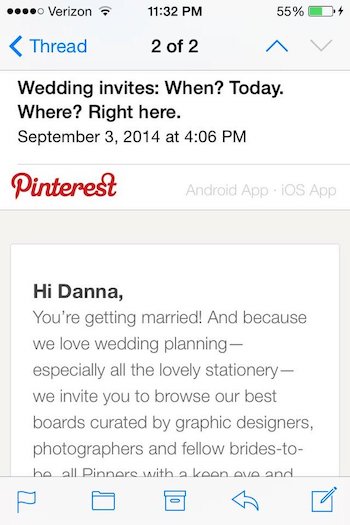
Remember that you have a margin of error around the assumptions you can make based on customer data. Avoid being creepy by familiarizing yourself with the potential causes of errors in your data. Avoid taking action based on mismatched data. Be aware of the high consequence of getting it wrong.
Personalization vs. stalking
You don’t need to know and follow everything about the customer; you don’t need to check-in at every step of everything they do. You don’t want to be perceived as pushy.
You don’t want to make them feel watched. Instead, make the customer feel noticed and respected.
Personalization vs. profiling
Profiling is a useful concept in marketing. We’ve all used segments in the execution of a marketing strategy. But profiling is not personalization (just like customization is not personalization).
Be careful about making assumptions that are based on a group’s behavior instead of the individual’s behavior. Don’t approach them like they’re a walking ATM, or like they’re just waiting to spend money on the same stuff people similar to them are spending money on. Instead, make the customer feel understood and demonstrate your interest in serving them.
How do you make personalization welcome and effective instead?
By adding value to the customer’s day. Imagine you’re the customer. You’ll be glad you received a personalized email if the personalization adds something that you would not get otherwise.
Our own examples from the marketing automation we’ve implemented include:
- Increased convenience and quality of service – we live in a convenience economy, after all
- Shorter path to what the customer wants – who wouldn’t want an easier way?
- Feeling of being understood – we all crave connection
- Feeling like a valued individual – this takes the timeless concept of “valued customer” three levels up
- Perceiving somebody’s interest in themselves – we all want to be noticed
- Enabling a choice – we all want to feel a level of control
Examples of best practice in email personalization
Real Thread case study: Personalized segmentation for B2B
Real Thread is a custom online t-shirt printer that prints for fashion lines, startups, and all sorts of businesses. The customer data infrastructure integrated with their marketing stack (which you can see in the image below) allows them to create a flow of data used for personalized segmentation of emails. Segment sends data to Clearbit for enrichment. The enriched data is passed on to the Autopilot and used for personalization:
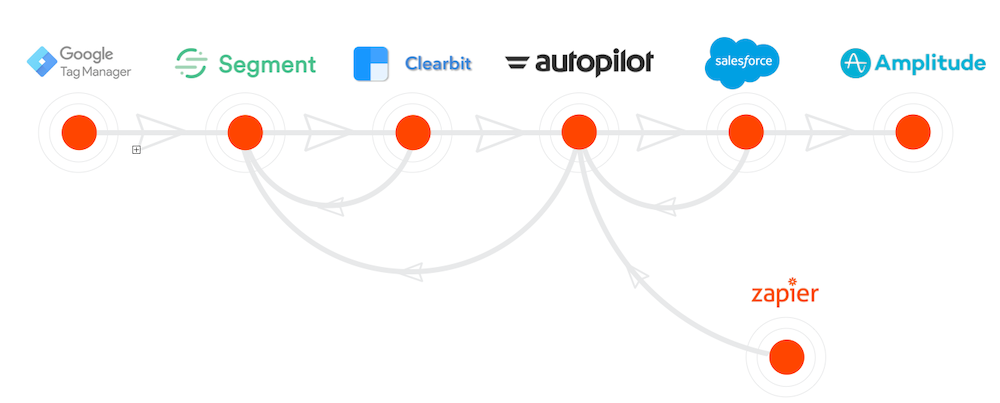
Here’s how it works:
- Real Thread collects data about purchase behavior, website behavior, and contact information of the customer.
- An email is sent out to customers. In this step, the company actively communicates to the customer that they want the customer’s help sending relevant emails. The customers click on a button to approve the personalization.
- The customer data infrastructure tool, Segment, sends the data on to the enrichment tool, Clearbit.
- The enriched data is used by the email tool, Autopilot, to create personalized profiles of the customers and to group them in segments. The segments can also be understood as buyer personas.
- Emails are tailored to the three segments created with personalization data – graphic designer, apparel designer, business owner.
As a result, Real Thread sends fewer emails, but each of them is more relevant to the customer and more effective to the business.
Carolina Designs case study: Personalized education for B2C
Carolina Designs is a luxury vacation rental company in Outer Banks, NC. They get most of the reservations through their website and they are constantly trying to make it easier for their customers to make a $25,000 decision. Great case for email personalization? Absolutely.
As you’d assume, the users with the potential to book will be quite thorough — they often book a vacation home to be shared by several families. The website caters to that. The users can save homes, compare homes to each other, and send themselves an email with the saved homes. One feature that is key to the brand’s personalization process is to offer an “Email me my saved homes” button on the website.
Carolina Designs then uses the user behavior data to nurture the lead. Some of the emails include reminders about the homes the user has saved:
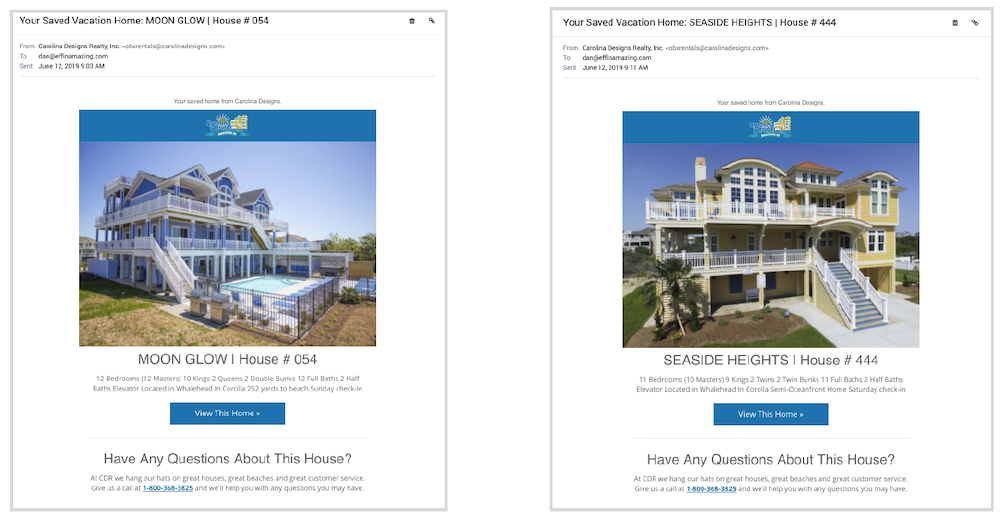
Users also receive personalized emails about the area they showed interest in. Here, the company delivers touchpoints that educate the user. Value is created by providing personalized inspiration and knowledge that will help someone plan or enjoy the luxury vacation:
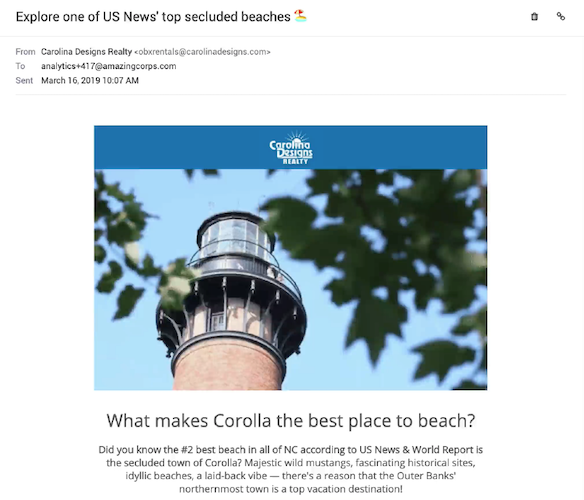
You can see how the personalized touchpoints are based on the prospect’s current knowledge, as well as their current funnel stage. This is the type of personalization that shows the prospect that you’re listening and that you care about making their purchase as valuable to them as possible.
This is the type of email personalization that customers now expect of marketing automation.
Effin Amazing example: Personalized content distribution
Effin Amazing is our agency. We are specialists in marketing technology and marketing analytics. And we provide heaps of educational content to our followers.
Our followers, just like your followers and everybody else’s, want control over what is sent to them. They want to have the choice of what emails they get. So take their opinions and needs into consideration. Give them the option to control the content distribution.
At the bottom of all our emails, there’s a link to the Preferences Center. As our email subscriber, you can choose which topics you want to receive in your inbox. If you click the link, you’re taken to this page, which has the analytics and martech topics we publish about that you can choose to receive, or not:
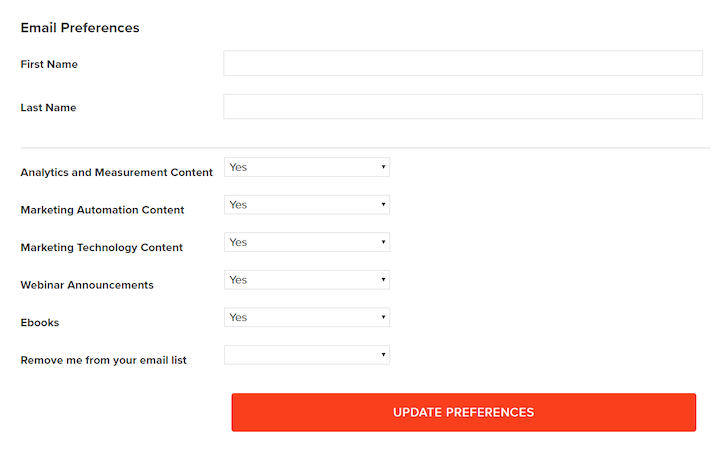
The options our subscribers choose get synced up with our marketing stack and email flows.
The structure of that stack is beyond the scope of this article, but one great step you can take now is to request a free copy of the amazing new martech book. You’ll learn everything you need to know to build a martech stack as amazing as ours, and to avoid martech mistakes.
The personalized content distribution via our email flows leads to better relationships, higher open and click rates, lower drop-off rates, and higher content engagement. I’m sure you understand how that leads to closing more deals.
Conclusion
Marketing personalization can be intimated to marketers. Sending creepy emails is a feared outcome.
But once you dive deep, you’ll find out it’s not too hard to get it right. We recommend you do so soon — personalized emails are an expected standard.
Focus on implementing a customer data infrastructure that enables personalization within an amazing marketing stack. Then, use email personalization to increase convenience, shorten customer journeys, convey understanding and respect, and enable a choice.
